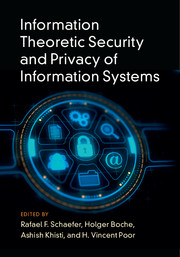Book contents
- Frontmatter
- Contents
- List of Contributors
- Preface
- Part I Theoretical Foundations
- Part II Secure Communication
- 5 Secrecy Rate Maximization in Gaussian MIMO Wiretap Channels
- 6 MIMO Wiretap Channels
- 7 MISO Wiretap Channel with Strictly Causal CSI: A Topological Viewpoint
- 8 Physical-Layer Security with Delayed, Hybrid, and Alternating Channel State Knowledge
- 9 Stochastic Orders, Alignments, and Ergodic Secrecy Capacity
- 10 The Discrete Memoryless Arbitrarily Varying Wiretap Channel
- 11 Super-Activation as a Unique Feature of Secure Communication over Arbitrarily Varying Channels
- Part III Secret Key Generation and Authentication
- Part IV Data Systems and Related Applications
- Index
- References
5 - Secrecy Rate Maximization in Gaussian MIMO Wiretap Channels
from Part II - Secure Communication
Published online by Cambridge University Press: 28 June 2017
- Frontmatter
- Contents
- List of Contributors
- Preface
- Part I Theoretical Foundations
- Part II Secure Communication
- 5 Secrecy Rate Maximization in Gaussian MIMO Wiretap Channels
- 6 MIMO Wiretap Channels
- 7 MISO Wiretap Channel with Strictly Causal CSI: A Topological Viewpoint
- 8 Physical-Layer Security with Delayed, Hybrid, and Alternating Channel State Knowledge
- 9 Stochastic Orders, Alignments, and Ergodic Secrecy Capacity
- 10 The Discrete Memoryless Arbitrarily Varying Wiretap Channel
- 11 Super-Activation as a Unique Feature of Secure Communication over Arbitrarily Varying Channels
- Part III Secret Key Generation and Authentication
- Part IV Data Systems and Related Applications
- Index
- References
Summary
Secrecy rate maximization in Gaussian MIMO wiretap channels is considered. While the optimality of Gaussian signaling and a general expression for the secrecy capacity have been well established, closed-form solutions for the optimal transmit covariance matrix are known for some special cases only, while the general case remains an open problem. This chapter reviews known closed-form solutions and presents a numerical algorithm for the general case with guaranteed convergence to the global optimum. The known solutions include full-rank and rank-1 cases (which, when combined, provide a complete solution for the case of two transmit antennas), the case of identical right singular vectors for the eavesdropper and legitimate channels, and the cases of weak, isotropic, and omnidirectional eavesdroppers, which also provide lower and upper bounds to the general case. Necessary optimality conditions and a tight upper bound for the rank of the optimal covariance matrix in the general case are discussed. Sufficient and necessary conditions for the optimality of three popular signaling strategies over MIMO channels, namely, isotropic and zero-forcing signaling as well as water-filling over the legitimate channel eigenmodes, are presented. The chapter closes with a detailed description of a numerical globally convergent algorithm to solve the general case, and gives some illustrative examples.
Introduction
Due to their high spectral efficiency, wireless MIMO (multiple input, multiple output) systems are widely adopted by academia and industry. The broadcast nature of wireless channels stimulated significant interest in their security aspects and the Gaussian MIMO wiretap channel (WTC) has emerged as a popular model to study information theoretic secrecy aspects of wireless systems [1]. A number of results have been obtained for this model, including the proof of optimality of Gaussian signaling [1–4], which is far from trivial and significantly more involved than that of the regular (no wiretap) MIMO channel. Once the functional form of the optimal input is established, the only unknown is its covariance matrix since the mean is always zero. This latter part has not been solved yet in the general case; only a number of special cases have been settled.
- Type
- Chapter
- Information
- Publisher: Cambridge University PressPrint publication year: 2017
References
- 2
- Cited by



